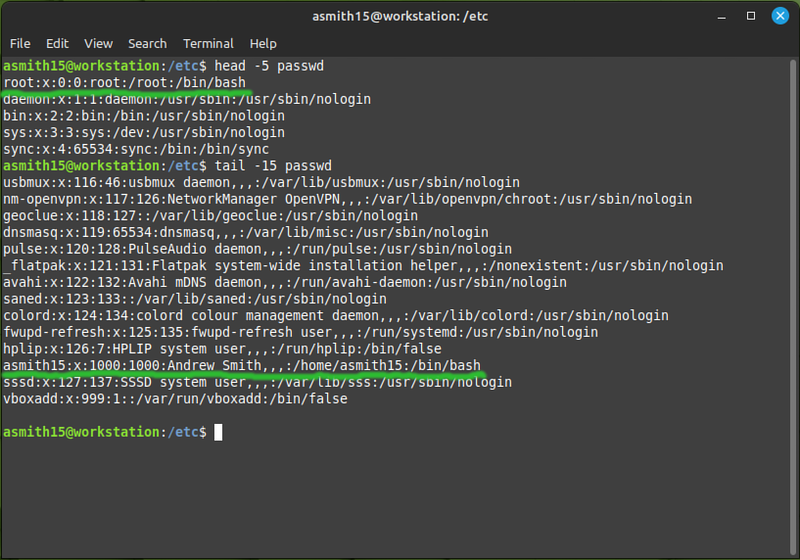OPS245 Lab 3: Difference between revisions
Jump to navigation
Jump to search
(Created page with "= !!!THIS LAB IS NOT READY YET!!! =") |
|||
| Line 1: | Line 1: | ||
= !!!THIS LAB IS NOT READY YET!!! = | = !!!THIS LAB IS NOT READY YET!!! = | ||
In this lab we'll look at the simplest types of user management on a Linux system. | |||
= What's a user = | |||
* Look at the contents of the /etc/passwd file: | |||
[[File:passwdFile.png|800px|border|center]] | |||
Every line in that file is a user. Two of them you have used explicitly: root and your own username. | |||
Each line is made of several fields, delimited by a colon. The same as a comma-separated value file (CSV) but separated by colons instead of commas. The fields are: | |||
* The '''username''' (e.g. asmith15) | |||
* A field that's no longer used, in the distant past it was the user's password | |||
* The '''UID''' (user ID) - a unique number identifying the user. The system uses these numbers to determine who owns which files and processes. | |||
* The '''GID''' (group ID) - the number identifying the user's primary group. Every user on a Linux system is a member of at least one group. It can be a member of other groups as well, but that membership is specified in the /etc/group file. | |||
* A '''comment''' - an unstructured string of text, usually used to store a user's full name. | |||
* The user's '''home directory'''. It's a sort of default directory for each user. You'll have noticed that it's the directory your shell is in when you log in, and it's what <code>~</code> and <code>$HOME</code> are set to. | |||
* The user's '''login shell'''. You would have only ever used Bash, but there are several other shells which some people prefer. The differences mostly matter only to advanced users. | |||
Revision as of 13:44, 26 January 2023
!!!THIS LAB IS NOT READY YET!!!
In this lab we'll look at the simplest types of user management on a Linux system.
What's a user
- Look at the contents of the /etc/passwd file:
Every line in that file is a user. Two of them you have used explicitly: root and your own username.
Each line is made of several fields, delimited by a colon. The same as a comma-separated value file (CSV) but separated by colons instead of commas. The fields are:
- The username (e.g. asmith15)
- A field that's no longer used, in the distant past it was the user's password
- The UID (user ID) - a unique number identifying the user. The system uses these numbers to determine who owns which files and processes.
- The GID (group ID) - the number identifying the user's primary group. Every user on a Linux system is a member of at least one group. It can be a member of other groups as well, but that membership is specified in the /etc/group file.
- A comment - an unstructured string of text, usually used to store a user's full name.
- The user's home directory. It's a sort of default directory for each user. You'll have noticed that it's the directory your shell is in when you log in, and it's what
~and$HOMEare set to. - The user's login shell. You would have only ever used Bash, but there are several other shells which some people prefer. The differences mostly matter only to advanced users.
